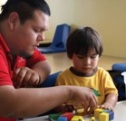
Ways to Prepare Your Child with Autism for School
By Dr. Cathy Pratt, BCBA-D, Director, Indiana Resource Center for Autism

Anticipating the beginning of the school year can create anxiety for both family members and for their sons/daughters on the autism spectrum. Concerns surround whether your son/daughter will be successful in school and whether the new staff will have a solid understanding of autism spectrum disorders (ASD) and of your son/daughter. At times, you may know staff and have a good working relationship with them. At other times, staff is unknown and expectations for your son/daughter are unclear. Below are a few tips to help you become a proactive and positive advocate for your son/daughter.
• Many teachers may not have previous experience with students with autism spectrum disorders or may only have had experience with students quite different than your son/daughter. The IRCA website at www.iidc.indiana.edu/irca has several articles that can help educators better understand ASD, including learning characteristics associated with ASD and teaching strategies. Proactively educate. Provide information, but do not overwhelm with too much information. Identify the autism leader in you special education planning district. (You can find a list of ASD leaders in your school district here.) Your local special education district autism leader may be able to assist with training or support.
• Staff will need information about how autism impacts your son/daughter. At the end of this article is a form that you can complete and share with your child’s teachers. This form allows you to provide specific information about learning styles, communication systems, medical issues, behavior supports and other topics. Make sure that you describe your child, and not only in terms related to their ASD (e.g., sense of humor, kind, gentle, smart). Highlight the positive qualities of your son/daughter. Ask that information be shared with relevant staff including cafeteria workers, custodians, bus drivers, the school secretary, the school nurse, and administrators. The form is brief so as not to overwhelm staff.
• Request information about bus schedules, parent teacher organizations, school rules, extracurricular options (e.g., clubs, sports) and available resources (e.g., counselors, social workers, nurses). Find out if there is a school website, Facebook, or some other means to stay connected with your child’s progress or events in the school.
• Before beginning the school year in a new school, work to alleviate any anxieties you or your son/daughter may have about the new setting. Preparation for this move can be facilitated by obtaining a map of the school, a copy of his/her schedule for the fall, a copy of the student handbook and rules, and a list of clubs/extracurricular activities. Ask to take a tour with your son/daughter before the school year begins. Request a list of school supplies, locker combination, and clothes needed for physical education. Practice getting up in the mornings and eating breakfast so the student and you will know how much time it will take him/her.
• Visit the lunchroom and have the student learn how to navigate the lunchroom, where to sit, and the rules of the lunchroom (e.g., going through the lunch line, sitting down in the lunchroom, etc.). Work with the staff to develop a social narrative or visual task analysis if needed.
• Ask the school to identify key people or a mentor the student can contact if s/he is having a difficult time adjusting or understanding a certain situation. Ask for the name and contact information for this person. This is especially important if your son/daughter is in middle school or high school.
• If possible, obtain pictures of your student’s teachers and staff, bus driver, cafeteria workers, etc.
• Classmates of the new student also may need information. This should be provided in a respectful manner and without stigmatizing the student on the autism spectrum. Talk to the teacher about how classmates will be informed. Here are articles that can help with educating elementary-age students and secondary-age students about ASD.
• At the very beginning of the new school year, establish methods and a schedule for communicating between home and school. Suggestions for maintaining ongoing communication include journals, daily progress notes, mid-term grades, scheduled appointments or phone calls, emails, informal meetings, report cards, or parent teacher conferences. Tell teachers the method of communication that works best for you (e.g., text, email, phone calls). Here are forms that can be used to facilitate home school communication.
• Be clear and proactive about what you hope for with your child. When school and home work more closely together, your son/daughter is the ultimate winner.
• At times rumors will circulate about your district, school, or personnel. If you hear a rumor, go to the source of it and have a conversation. Not everything on listservs, Facebook, and emails is accurate. Do not jump to judgment. Your only goal should be to ensure that all work collaboratively on behalf of your son/daughter.
The ultimate goal is to promote a successful experience for both your child and for you. By proactively and positively working with the school, challenges can be minimized and trust built.
Download this information form about your child.(*This PDF opens in new window)
Check your child's development before your he/she begins pre-school or kindergarten with the Ages & Stages Questionnaires®.


 By Mids Meinberg
By Mids Meinberg Online spaces benefit from being very accessible. Computer technology has reached the point where almost everyone can use the internet, so long as they have the right accessibility tools available. The ability to access the internet from home is great for people with mobility disabilities and those that cannot otherwise get to places. The emphasis on just words, rather than words and non-verbal communication, (except in easily parsable emojis) also makes text communication much easier for many neurodivergent people. The ability of multiple people to write at once and have a legible conversation helps a lot with me, as otherwise my social anxiety makes it difficult to know when it’s okay for me to talk.
Online spaces benefit from being very accessible. Computer technology has reached the point where almost everyone can use the internet, so long as they have the right accessibility tools available. The ability to access the internet from home is great for people with mobility disabilities and those that cannot otherwise get to places. The emphasis on just words, rather than words and non-verbal communication, (except in easily parsable emojis) also makes text communication much easier for many neurodivergent people. The ability of multiple people to write at once and have a legible conversation helps a lot with me, as otherwise my social anxiety makes it difficult to know when it’s okay for me to talk.
 By Mids Meinberg
By Mids Meinberg


Connect with us on social media